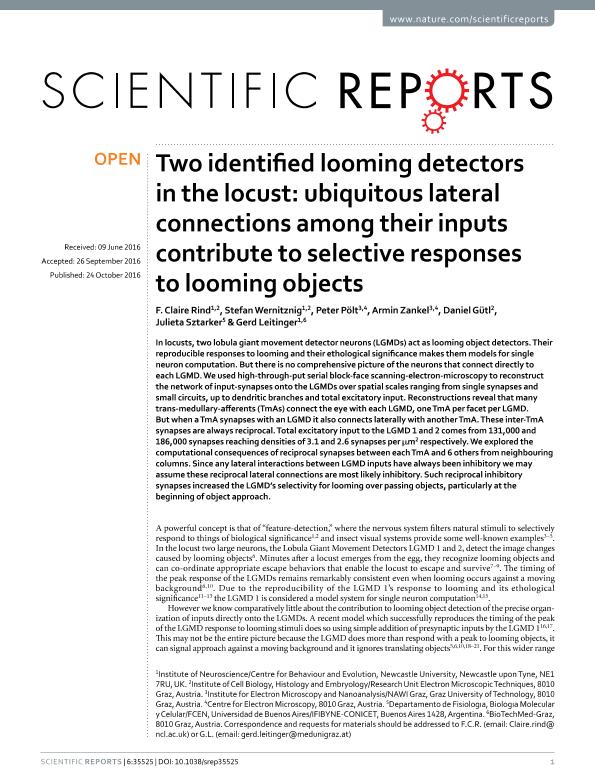Mostrar el registro sencillo del ítem
dc.contributor.author
Rind, F. Claire
dc.contributor.author
Wernitznig, Stefan
dc.contributor.author
Pölt, Peter
dc.contributor.author
Zankel, Armin
dc.contributor.author
Gütl, Daniel
dc.contributor.author
Sztarker, Julieta

dc.contributor.author
Leitinger, Gerd
dc.date.available
2018-10-01T19:35:25Z
dc.date.issued
2016-10
dc.identifier.citation
Rind, F. Claire; Wernitznig, Stefan; Pölt, Peter; Zankel, Armin; Gütl, Daniel; et al.; Two identified looming detectors in the locust: Ubiquitous lateral connections among their inputs contribute to selective responses to looming objects; Nature Publishing Group; Scientific Reports; 6; 10-2016; 1-16
dc.identifier.issn
2045-2322
dc.identifier.uri
http://hdl.handle.net/11336/61432
dc.description.abstract
In locusts, two lobula giant movement detector neurons (LGMDs) act as looming object detectors. Their reproducible responses to looming and their ethological significance makes them models for single neuron computation. But there is no comprehensive picture of the neurons that connect directly to each LGMD. We used high-through-put serial block-face scanning-electron-microscopy to reconstruct the network of input-synapses onto the LGMDs over spatial scales ranging from single synapses and small circuits, up to dendritic branches and total excitatory input. Reconstructions reveal that many trans-medullary-afferents (TmAs) connect the eye with each LGMD, one TmA per facet per LGMD. But when a TmA synapses with an LGMD it also connects laterally with another TmA. These inter-TmA synapses are always reciprocal. Total excitatory input to the LGMD 1 and 2 comes from 131,000 and 186,000 synapses reaching densities of 3.1 and 2.6 synapses per μm 2 respectively. We explored the computational consequences of reciprocal synapses between each TmA and 6 others from neighbouring columns. Since any lateral interactions between LGMD inputs have always been inhibitory we may assume these reciprocal lateral connections are most likely inhibitory. Such reciprocal inhibitory synapses increased the LGMD's selectivity for looming over passing objects, particularly at the beginning of object approach.
dc.format
application/pdf
dc.language.iso
eng
dc.publisher
Nature Publishing Group

dc.rights
info:eu-repo/semantics/openAccess
dc.rights.uri
https://creativecommons.org/licenses/by-nc-sa/2.5/ar/
dc.subject
Colision Avoidance
dc.subject
Locust
dc.subject
Lgmd
dc.subject
Electron Microscopy
dc.subject.classification
Otras Ciencias Biológicas

dc.subject.classification
Ciencias Biológicas

dc.subject.classification
CIENCIAS NATURALES Y EXACTAS

dc.title
Two identified looming detectors in the locust: Ubiquitous lateral connections among their inputs contribute to selective responses to looming objects
dc.type
info:eu-repo/semantics/article
dc.type
info:ar-repo/semantics/artículo
dc.type
info:eu-repo/semantics/publishedVersion
dc.date.updated
2018-10-01T16:10:11Z
dc.journal.volume
6
dc.journal.pagination
1-16
dc.journal.pais
Reino Unido

dc.journal.ciudad
Londres
dc.description.fil
Fil: Rind, F. Claire. University of Newcastle; Reino Unido. Medical University of Graz. Institute of Cell Biology, Histology and Embryology; Austria
dc.description.fil
Fil: Wernitznig, Stefan. University of Newcastle; Reino Unido. Medical University of Graz. Institute of Cell Biology, Histology and Embryology; Austria
dc.description.fil
Fil: Pölt, Peter. Graz University of Technology; Austria. Graz Centre for Electron Microscopy; Austria
dc.description.fil
Fil: Zankel, Armin. Graz University of Technology; Austria. Graz Centre for Electron Microscopy; Austria
dc.description.fil
Fil: Gütl, Daniel. Medical University of Graz. Institute of Cell Biology, Histology and Embryology; Austria
dc.description.fil
Fil: Sztarker, Julieta. Consejo Nacional de Investigaciones Científicas y Técnicas. Oficina de Coordinación Administrativa Ciudad Universitaria. Instituto de Fisiología, Biología Molecular y Neurociencias. Universidad de Buenos Aires. Facultad de Ciencias Exactas y Naturales. Instituto de Fisiología, Biología Molecular y Neurociencias; Argentina
dc.description.fil
Fil: Leitinger, Gerd. University of Newcastle; Reino Unido. BioTechMed Graz; Austria
dc.journal.title
Scientific Reports
dc.relation.alternativeid
info:eu-repo/semantics/altIdentifier/doi/http://dx.doi.org/10.1038/srep35525
dc.relation.alternativeid
info:eu-repo/semantics/altIdentifier/url/https://www.nature.com/articles/srep35525
Archivos asociados
